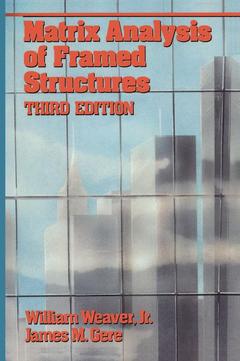Matrix Analysis Framed Structures, Softcover reprint of the original 1st ed. 1990
Langue : Anglais
Auteurs : Weaver William, Gere James M.

Matrix analysis of structures is a vital subject to every structural analyst, whether working in aero-astro, civil, or mechanical engineering. It provides a comprehensive approach to the analysis of a wide variety of structural types, and therefore offers a major advantage over traditional metho~ which often differ for each type of structure. The matrix approach also provides an efficient means of describing various steps in the analysis and is easily programmed for digital computers. Use of matrices is natural when performing calculations with a digital computer, because matrices permit large groups of numbers to be manipulated in a simple and effective manner. This book, now in its third edition, was written for both college students and engineers in industry. It serves as a textbook for courses at either the senior or first-year graduate level, and it also provides a permanent reference for practicing engineers. The book explains both the theory and the practical implementation of matrix methods of structural analysis. Emphasis is placed on developing a physical understanding of the theory and the ability to use computer programs for performing structural calculations.
1 Basic Concepts of Structural Analysis.- 1.1 Introduction.- 1.2 Types of Framed Structures.- 1.3 Deformations in Framed Structures.- 1.4 Actions and Displacements.- 1.5 Equilibrium.- 1.6 Compatibility.- 1.7 Static and Kinematic Indeterminacy.- 1.8 Structural Mobilities.- 1.9 Principle of Superposition.- 1.10 Action and Displacement Equations.- 1.11 Flexibility and Stiffness Matrices.- 1.12 Equivalent Joint Loads.- 1.13 Energy Concepts.- 1.14 Virtual Work.- References.- Problems.- 2 Fundamentals of the Flexibility Method.- 2.1 Introduction.- 2.2 Flexibility Method.- 2.3 Examples.- 2.4 Temperature Changes, Prestrains, and Support Displacements.- 2.5 Joint Displacements, Member End-Actions, and Support Reactions.- 2.6 Flexibilities of Prismatic Members.- 2.7 Formalization of the Flexibility Method.- Problems.- 3 Fundamentals of the Stiffness Method.- 3.1 Introduction.- 3.2 Stiffness Method.- 3.3 Examples.- 3.4 Temperature Changes, Prestrains and Support Displacements.- 3.5 Stiffness of Prismatic Members.- 3.6 Formalization of the Stiffness Method.- Problems.- 4 Computer-Oriented Direct Stiffness Method.- 4.1 Introduction.- 4.2 Direct Stiffness Method.- 4.3 Complete Member Stiffness Matrices.- 4.4 Formation of Joint Stiffness Matrix.- 4.5 Formation of Load Vector.- 4.6 Rearrangement of Stiffness and Load Arrays.- 4.7 Calculation of Results.- 4.8 Analysis of Continuous Beams.- 4.9 Example.- 4.10 Plane Truss Member Stiffnesses.- 4.11 Analysis of Plane Trusses.- 4.12 Example.- 4.13 Rotation of Axes in Two Dimensions.- 4.14 Application to Plane Truss Members.- 4.15 Rotation of Axes in Three Dimensions.- 4.16 Plane Frame Member Stiffnesses.- 4.17 Analysis of Plane Frames.- 4.18 Example.- 4.19 Grid Member Stiffnesses.- 4.20 Analysis of Grids.- 4.21 Space Truss Member Stiffnesses.- 4.22 Selection of Space Truss Member Axes.- 4.23 Analysis of Space Trusses.- 4.24 Space Frame Member Stiffnesses.- 4.25 Analysis of Space Frames.- Problems.- 5 Computer Programs for Framed Structures.- 5.1 Introduction.- 5.2 FORTRAN Programming and Flow Charts.- 5.3 Program Notation.- 5.4 Preparation of Data.- 5.5 Description of Programs.- 5.6 Continuous Beam Program.- 5.7 Plane Truss Program.- 5.8 Plane Frame Program.- 5.9 Grid Program.- 5.10 Space Truss Program.- 5.11 Space Frame Program.- 5.12 Combined Program for Framed Structures.- References.- 6 Additional Topics for the Stiffness Method.- 6.1 Introduction.- 6.2 Rectangular Framing.- 6.3 Symmetric and Repeated Structures.- 6.4 Loads Between Joints.- 6.5 Automatic Dead Load Analysis.- 6.6 Temperature Changes and Prestrains.- 6.7 Support Displacements.- 6.8 Oblique Supports.- 6.9 Elastic Supports.- 6.10 Translation of Axes.- 6.11 Member Stiffnesses and Fixed-End Actions from Flexibilities.- 6.12 Nonprismatic Members.- 6.13 Curved Members.- 6.14 Releases in Members.- 6.15 Elastic Connections.- 6.16 Shearing Deformations.- 6.17 Offset Connections.- 6.18 Axial-Flexural Interactions.- 6.19 Axial Constraints in Frames.- References.- Problems.- 7 Finite-Element Method for Framed Structures.- 7.1 Introduction.- 7.2 Stresses and Strains in Continua.- 7.3 Virtual-Work Basis of Finite-Element Method.- 7.4 One-Dimensional Elements.- 7.5 Application to Framed Structures.- References.- General References.- Notation.- Appendix A. Displacements of Framed Structures.- A.1 Stresses and Deformations in Slender Members.- A.2 Displacements by the Unit-Load Method.- A.3 Displacements of Beams.- A.4 Integrals of Products for Computing Displacements.- References.- Appendix B. End-Actions for Restrained Members.- Appendix C. Properties of Sections.- Appendix D. Computer Routines for Solving Equations.- D.1 Factorization Method for Symmetric Matrices.- D.2 Subprogram FACTOR.- D.3 Subprogram SOLVER.- D.4 Subprogram BANFAC.- D.5 Subprogram BANSOL.- References.- Appendix E. Solution without Rearrangement.- Answers to Problems.- Order Form for Diskette.
Date de parution : 11-2012
Ouvrage de 547 p.
15.2x22.9 cm
Mots-clés :
Calc; Fundament; beam; computer; deformation; finite element method; flow; matrix; mechanical engineering; rotation; space; stress; structural analysis; structure; structures
© 2024 LAVOISIER S.A.S.



